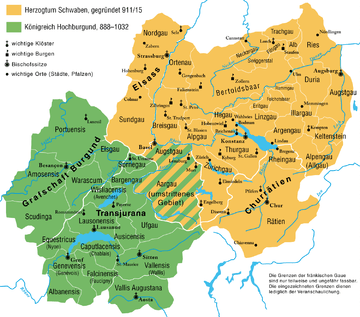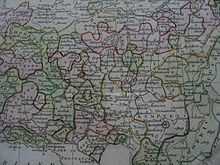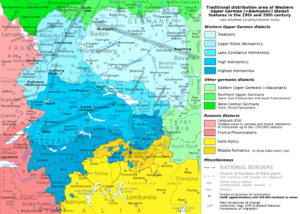Swabia
.svg.png)
Swabia (/ˈsweɪbiə/; German: Schwaben, colloquially Schwabenland or Ländle; in English also sometimes Suabia or Svebia) is a cultural, historic and linguistic region in southwestern Germany. The name is ultimately derived from the medieval Duchy of Swabia, one of the German stem duchies, representing the territory of Alemannia, whose inhabitants were interchangeably called Alemanni or Suebi. This territory would include all of the Alemannic German areal, but the modern concept of Swabia is more restricted, due to the collapse of the duchy of Swabia in the 13th century. Swabia as understood in modern ethnography roughly coincides with the Swabian Circle of the Holy Roman Empire as it stood during the Early Modern period, now divided between the states of Bavaria and Baden-Württemberg.
Swabians (Schwaben, singular Schwabe) are the natives of Swabia and speakers of Swabian German. Their number was estimated at close to 0.8 million by SIL Ethnologue as of 2006, compared to a total population of 7.5 million in the regions of Tübingen, Stuttgart Bavarian Swabia.
Geography
Like many cultural regions of Europe, Swabia's borders are not clearly defined. However, today it is normally thought of as comprising the former Swabian Circle, or equivalently the former state of Württemberg (with the Prussian Hohenzollern Province), or the modern districts of Tübingen, Stuttgart, and the administrative region of Bavarian Swabia.
In the Middle Ages, the term Swabia indicated a larger area, covering all the lands associated with the Frankish stem duchy of Alamannia stretching from the Vosges Mountains in the west to the broad Lech river in the east: This also included the region of Alsace and the later Margraviate of Baden on both sides of the Upper Rhine Valley, as well as modern German-speaking Switzerland, the Austrian state of Vorarlberg and the Principality of Liechtenstein in the south.
History

Antiquity
Like all of Southern Germany, Swabia was part of the La Tène culture, and as such has a Celtic substrate. In the Roman era, it was part of the Raetia province. In the 3rd century, it was gradually settled by the Elbe Germanic Suebi and other components that came to make up the Alemanni. The Alamanni were ruled by independent kings throughout the 4th and 5th centuries.[1] By the late 5th century, the area settled by the Alemanni extended to the Alsace and the Swiss Plateau, bordering on the Bavarii to the east, the Franks to the north, the remnants of Roman Gaul to the west, and the Lombards and Goths, united in the Kingdom of Odoacer, to the south.
Duchy of Swabia
Swabia became a duchy under the Frankish Empire in 496, following the Battle of Tolbiac. Swabia was one of the original stem duchies of East Francia, the later Holy Roman Empire, as it developed in the 9th and 10th centuries. Due to the foundation of the important abbeys of St. Gallen and Reichenau, Swabia became an important center of Old High German literary culture during this period. The Hohenstaufen dynasty (the dynasty of Frederick Barbarossa), which ruled the Holy Roman Empire in the 12th and 13th centuries, arose out of Swabia, but following the execution of Conradin, the last Hohenstaufen, on October 29, 1268, the original duchy gradually broke up into many smaller units.
Later medieval period
Charlemagne's family is known to have hailed from Swabia. The major dynasties that arose out of the region were the Habsburgs and the Hohenzollerns, who rose to prominence in Northern Germany. Also stemming from Swabia are the local dynasties of the Dukes of Württemberg and the Margraves of Baden. The Welf family went on to rule in Bavaria and Hanover, and are ancestral to the British royal family that has ruled since 1714. Smaller feudal dynasties eventually disappeared, however; for example, branches of the Montforts and Hohenems lived until modern times, and the Fürstenberg survive still. The region proved to be one of the most divided in the Empire, containing, in addition to these principalities, numerous free cities, ecclesiastical territories, and fiefdoms of lesser counts and knights.
Early modern history
The territory of Swabia as understood today emerges in the early modern period. It corresponds to the Swabian Circle established in 1512. The Old Swiss Confederacy was de facto independent from Swabia from 1499 as a result of the Swabian War, while the Margraviate of Baden had been detached from Swabia since the 12th century.
Fearing the power of the greater princes, the cities and smaller secular rulers of Swabia joined to form the Swabian League in the 15th century. The League was quite successful, notably expelling the Duke of Württemberg in 1519 and putting in his place a Habsburg governor, but the league broke up a few years later over religious differences inspired by the Reformation, and the Duke of Württemberg was soon restored.

The region was quite divided by the Reformation. While secular princes like the Duke of Württemberg and the Margrave of Baden-Durlach, as well as most of the Free Cities, became Protestant, the ecclesiastical territories (including the bishoprics of Augsburg, Konstanz and the numerous Imperial abbeys) remained Catholic, as did the territories belonging to the Habsburgs (Further Austria), Hohenzollerns and the Margrave of Baden-Baden.
Modern history
In the wake of the territorial reorganization of the Empire of 1803 by the Reichsdeputationshauptschluss, the shape of Swabia was entirely changed. All the ecclesiastical estates were secularized, and most of the smaller secular states, and almost all of the free cities, were mediatized, leaving only Württemberg, Baden and Hohenzollern as sovereign states. Much of Eastern Swabia became part of Bavaria, forming what is now the Swabian administrative region of Bavaria.
The Nazi propaganda film Jud Süß took place in the Kingdom of Württemberg, with the Swabians shown being terrorized by Jews.
Swabian people
Language

SIL Ethnologue cites an estimate of 819,000 Swabian speakers as of 2006. This corresponds to roughly 10% of the total population of the Swabian region, or roughly 1% of the total population of Germany.
As an ethno-linguistic group, Swabians are closely related to other speakers of Alemannic German, i.e. Badeners, Alsatians, and German-speaking Swiss.[2]
Swabian German is traditionally spoken in the upper Neckar basin (upstream of Heilbronn), along the upper Danube between Tuttlingen and Donauwörth, and on the left bank of the Lech, in an areal centered on the Swabian Alps roughly stretching from Stuttgart to Augsburg.
Many Swabian surnames end with the suffixes -le, -(l)er, -el, -ehl, and -lin, typically from the Middle High German diminutive suffix -elîn (Modern Standard German -lein). Examples would be: Schäuble, Egeler, Rommel, and Gmelin. The popular surname Schwab is derived from this area, meaning literally "Swabian".
List of notable Swabians
- Friedrich Adler, Jugendstil and Art Deco designer
- Roland Asch, race driver
- Dieter Baumann, Olympic gold medalist and anti-doping activist
- Albrecht Behmel, writer and historian
- Götz von Berlichingen, "the knight with the iron fist"
- Robert Bosch, inventor, industrialist and philanthropist
- Berthold Brecht, poet and playwright
- Gottlieb Daimler, developer of the second modern car (presented November 1886), 10 months after Karl Benz' patent of January 29, 1886. Founder of Daimler Motoren Gesellschaft, today: Daimler
- Dieter Dengler, Wildberg-born US pilot & Vietnam POW
- Rudolf Diesel, Engineer & Inventor of the Diesel Engine
- Josef Eberle, Swabian Poet who versed Swabian poems
- Albert Einstein, physicist, Nobel laureate
- Siegfried Einstein, poet
- Georg Elser, tried to assassinate Adolf Hitler in Munich in 1939
- Roland Emmerich, Hollywood director
- Gudrun Ensslin, a founder of the German terrorist group Red Army Faction or RAF, a.k.a. the Baader-Meinhof Gang
- Hartmut Esslinger, industrial designer and founder of design consultancy Frog Design Inc.
- Johann Georg Faust, protagonist of tales and dramas
- Wilhelm Groener, railroad chief in the German General Staff, Minister of Transportation, Minister of Defense, and acting Minister of the Interior in the Weimar Republic
- Alfred Haag, Communist & member of German Resistance
- Lina Haag, Communist & member of German Resistance
- Philipp Matthäus Hahn, priest and inventor
- Erich Hartmann, highest-scoring ace of WWII, 352 victories
- Wilhelm Hauff, poet
- Georg Wilhelm Friedrich Hegel, philosopher
- Martin Heidegger, philosopher
- Ernst Heinkel, aircraft designer
- Herman the Cripple, blessed of the Catholic Church and author of the "Salve Regina"
- Hermann Hesse, poet, writer, 1946 Nobel laureate for Literature
- Theodor Heuss, former President of the Federal Republic of Germany
- Friedrich Hölderlin, poet
- Uli and Dieter Hoeneß, former football players and managers
- Friedrich Gustav Jaeger, German officer during World War II who participated in an assassination attempt on Hitler
- Alfred Kärcher, Inventor, founder of Kärcher Cleaning equipment
- Johannes Kepler, astronomer and mathematician
- Justinus Kerner, poet
- Carl Friedrich Kielmeyer, biologist
- Kurt Georg Kiesinger, former Chancellor of the Federal Republic of Germany
- Jürgen Klinsmann, football (soccer) player, current coach of the United States men's national soccer team, and former coach of the Germany national football team and FC Bayern München
- Jürgen Klopp, football coach, current coach of Borussia Dortmund
- Sándor Wekerle, former Prime Minister of Hungary
- Ignaz Semmelweis, physician and an early pioneer of antiseptic procedures
- Stefan Hell, Nobel Prize-winning physician
- Ferenc Erkel, composer
- Franz Liszt, composer
- Carl Laemmle, founder of Universal Studios in Hollywood
- Johann von Leuchselring, Chancellor of Augsburg
- Ottmar Mergenthaler, inventor of the linotype
- Eduard Mörike, poet
- Leopold Mozart, father of Wolfgang Amadeus Mozart—the family originally came from Swabia
- Gerd Müller, former football (soccer) player
- Johannes Nauclerus, historian, university rector/chancellor
- Friedrich Immanuel Niethammer, theologian, philosopher and patron of Hegel
- Erwin Rommel, World War II general
- Friedrich Wilhelm Joseph Schelling, philosopher
- Friedrich Schiller, historian and writer, Wilhelm Tell, Die Räuber, Maria Stuart, "Ode an die Freude"/"Ode to Joy"
- Harald Schmidt, late-night talk show host
- Heinz-Wolfgang Schnaufer, highest scoring nightfighter ace of WWII, 121 victories
- Hans Schober, structural engineer
- Hans Scholl, founder of the White Rose resistance against the Nazis
- Sophie Scholl, member of the White Rose resistance against the Nazis
- Bernd Schuster, former football player and coach
- Gustav Schwab, writer, most popular for "die schönsten Sagen des klassischen Altertums"
- Claus von Stauffenberg, leader of the July 20 plot to assassinate Adolf Hitler
- Margarete Steiff, toy maker
- Andreas Stihl, founder of Stihl Maschinenfabrik
- Ludwig Uhland, poet
- Richard Vogt, aircraft designer
- Richard von Weizsäcker, former President of the Federal Republic of Germany
- Ferdinand von Zeppelin Airship manufacturer
Pejorative usage of "Swabian"
In Switzerland, Schwab is a generic term for Germans. It may be turned into a derogative by prefixing Sau- "pig", as in Sauschwabe. The division of Alemannic Swiss from the Swabians can be traced to the Swabian War of 1499. In Macedonian, Polish, and Bulgarian, "Shvab" or "Szwab" may be a pejorative term for any German, not just one from Swabia. In parts of the former Yugoslavia (i.e., Serbia, Montenegro, Slovenia, Croatia, Bosnia and Herzegovina), the more neutral term Švabo is somewhat applied to all German peoples who lived in those regions until shortly after World War II (called Danube Swabians though most of them came from neighboring Lorraine and the Palatinate), and to their descendants; it is even occasionally used as a slang or derogatory term to refer to all German speakers including Austrians and Swiss Germans.
See also
- Danube Swabians (Donauschwaben): Banat Swabians, Germans of Serbia, Satu Mare Swabians, Swabian Turkey
- Duke of Swabia
- Swabian children
- New Swabia
- Swabian League
- Schwaben Redoubt (World War I)
References
- ↑ Also, a number of Suebi reached the Iberian Peninsula under king Hermeric and established an independent kingdom known as the Galliciense Regnum, which existed during 410–585. See Victor Vitense Persecutiones, I.
- ↑ James Minahan. One Europe, Many Nations: A Historical Dictionary of European National Groups. Greenwood Publishing Group, Ltd., 2000. P. 650.
External links
| Look up Swabia in Wiktionary, the free dictionary. |
| Wikimedia Commons has media related to Swabia. |
- D'alemannisch Wikipedia
- "Danube Swabian Resources".
 Texts on Wikisource:
Texts on Wikisource:
- "Swabia". The New Student's Reference Work. 1914.
- "Swabia". Encyclopædia Britannica (11th ed.). 1911.
- "Swabia". New International Encyclopedia. 1905.